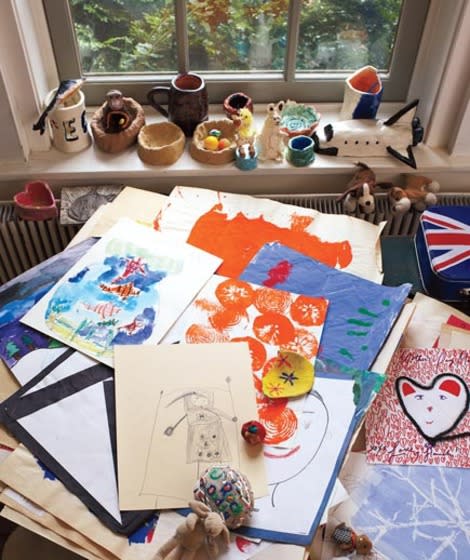How to Let Go of Sentimental Clutter
By Marjorie Ingall
When my dad died, several years ago, he left behind a legacy of love and a terrifying number of frogs. Part of me wanted to keep every last one. These things were a connection to my dad, a connection to my childhood. But I live in a New York City apartment. Had I kept all those frogs, my life would be an all-amphibian episode of Hoarders.
I know I'm not alone in my desire to hang on to objects with emotional value. How many of us have boxes of unsorted photos in the corners of our homes? How many of us struggle with the desire to preserve each painting, Popsicle-stick creation, and pinch pot cranked out by our kids?
See More: The Top 6 Causes of Clutter
Julie Holland, M.D., an assistant clinical professor of psychiatry at New York University School of Medicine, assures us that the urge to hold on to meaningful possessions is normal. "These are transitional objects. Sentimental clutter is the adult equivalent of a teddy bear," she says. "We worry--consciously or unconsciously--that we'll feel alone in the world if we don't have our stuff."
Organizing consultant Ellen Madere, in Old Lyme, Connecticut (ellengetsitdone.com), says it's about working with the emotional aspects of the process, not against them. Here are her steps for conquering the challenge.
See More: Clutter-Busting Secrets of the Pros
Step 1: Box It Up
Don't let fate (or a leaky basement) determine what you save and what you don't. Even if you're not ready to purge, "put things in 'question boxes,' label them, and stash them somewhere safe and dry," says Madere. If you happen upon obvious junk, toss it and pat yourself on the back. For some, the next step is to let a bit of time pass. "If you're in a tender emotional state," says Madere, "grieving because of a death, downsizing into a smaller home, or in an empty-nest situation, it's best to wait about six months before sorting through anything difficult."
See More: Storage Ideas for Small Spaces
Step 2: Enlist Help, If You Need It
Just make sure it's the right kind of help. Do you need someone warm and fuzzy because the work would be unbearable alone? Or do you want a tech-savvy whip-cracker who can post images of your sellables on eBay while getting your nose out of that old diary? "Sometimes it's just company--it's nice to have another body in the room to bounce ideas off of," says Madere.
See More: Keep It or Sell It?
Step 3: Work in Short Intervals
Going through emotionally loaded items can make you feel depleted, so limit work sessions to three or four hours. If you're convinced that you can turn your home into a clutter-free paradise in one 12-hour blitz, this rule will be tough to follow. But a fresh, rested mind will help you make smart decisions and avoid Purger's Regret. When you're stuck about whether to keep or divest, ask yourself: What's significant about this object? Does it have genuine, lasting emotional value? Do I like it enough to display it, or will it be in a box forever? Would it be more valuable to someone else?
See More: De-Cluttering Solutions for Your Home
Step 4: Take a Picture (It Lasts Longer)
Admittedly, a digital image is not the thing itself. There's no tactile joy to it. But storing something on a computer doesn't just save space; it also minimizes risk from a preservationist standpoint. "Even with archival paper and plastic sleeves, physical objects can fade or get lost," says Madere. You can ship off old snapshots and have them converted to digital form by services like gophoto.com. You might also want to photograph meaningful items before letting them go. And if you're clearing a whole house after, for example, the loss of a loved one, Madere suggests taking pictures of the rooms first, or asking a friend to, if the task is too emotional. "You can make lovely books at blurb.com to preserve the memories in a form you can hold," says Madere.
See More: Organizing Your Digital Photos
Which brings us nicely to every parent's bugaboo: children's artwork. The art writer Casey Ellis (brilliantly) suggested that I tell my kids I was creating a catalogue raisonné of their work. This is a fancy term for a complete list of an artist's output. It sounds impressive, and it means that the original pieces, after being scanned or photographed, can be farmed out to collectors (a.k.a. Grandma) or recycled. Their memories live on in my Flickr pages, to be admired at the kids' leisure. (So far, that means never.)
See More: How to Let Go of Sentimental Clutter
Don't Miss:
5 Writers Describe the Sentimental Value of Everyday Things
Organizing and Storage Solutions for Your Kids' Clutter
Conquer Your Biggest Clutter Challenges

